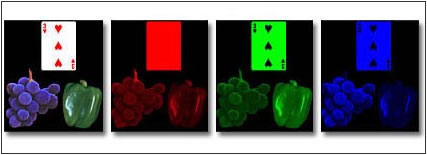
You are here: Home >> Encyclopedia of Light >> Colors
Human eye is sensitive to electromagnetic radiation with wavelength which lies between 400 and 700 nm (nanometres). The mixture of all wavelengths between 400 and 700 nm gives the white light. As we have seen a prism can analyse white light to its components. However the additive mixture of red, blue and green also gives the white light. These colors are the primary ones. Where red and blue light overlap, we can see magenta. Where red and green light overlap, we can see yellow. Where green and blue light overlap, can see cyan. Magenta, yellow and cyan form the complementery colors. White light can be made by various combinations, such as yellow with blue, magenta with green, cyan with red, and by mixing all of the colors together.
Where red and blue light overlap, we can see magenta. Where red and green light overlap, we can see yellow. Where green and blue light overlap, can see cyan. Magenta, yellow and cyan form the complementery colors. White light can be made by various combinations, such as yellow with blue, magenta with green, cyan with red, and by mixing all of the colors together.
We can also see colors by absorption of certain frequencies of light. Thinking that an orange orange absorbs all colors apart from orange (which is reflected) and the same goes for a green pepper we could throw orange light onto the orange and the pepper. The orange will be still orange, but the pepper will appear black (or almost black, because there will always be a part of a pady which reflects light). Then if we throw green light the pepper will appear green and the orange black.
Mixing magenta, cyan and yellow, and then drawing three overlapping circles with those colors, we would see that where magenta with yellow is combined, the result is red. Mixing cyan with yellow produces green, and mixing cyan with magenta creates blue.
Black is the special case in which all of the colors are absorbed. Black is made by combining yellow with blue, cyan with red or magenta with green. These combinations make all colors be absorbed and as a result we see black.  On the above principle lies the manufacture and use of filters in photography, movies etc. These filters are made in order to absorb or to reflect part or whole light components apart from the desired one.
On the above principle lies the manufacture and use of filters in photography, movies etc. These filters are made in order to absorb or to reflect part or whole light components apart from the desired one.
For example a filter may absorb all colors except for yellow. These are the absorption filters. There are the interference filters as well. The interference filters reflect an unwanted color, but they let pass the components that create the desired color. For example a lilter like this may reflect all colors and let red and green pass. We finally perceive yellow, bacause the primary colors red and green give yellow.